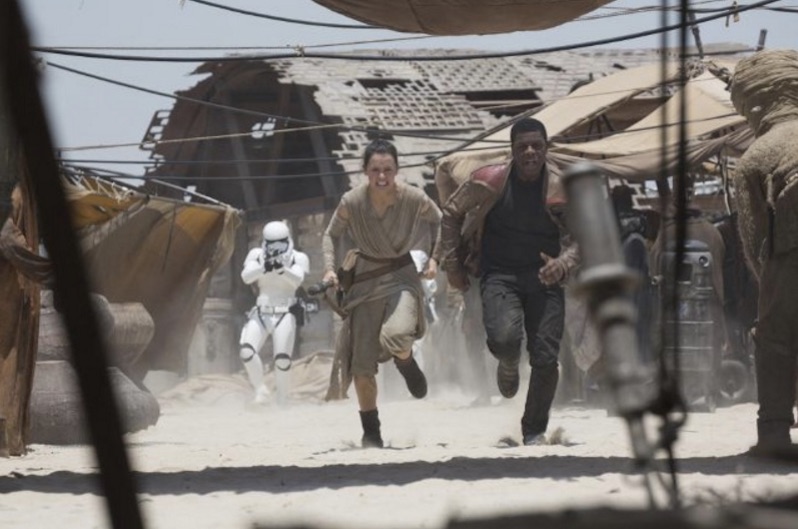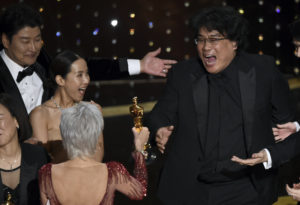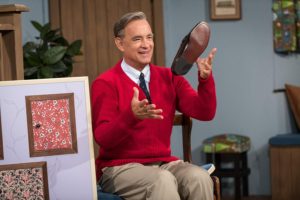The Year in Movies: Superheroines, Superheroes, Singers and Sex
When it came to the silver screen, 2015 was a curious and contradictory year in many ways. It featured the success of both the legacy franchise and the original script, and it brought together both warrior babes and geriatric macho men. Daisy Ridley and John Boyega in a scene from "Star Wars: The Force Awakens." (IMDb)
Daisy Ridley and John Boyega in a scene from "Star Wars: The Force Awakens." (IMDb)
Daisy Ridley and John Boyega in a scene from “Star Wars: The Force Awakens.” (IMDb)
Filmwise, 2015 was a curious, sometimes contradictory, year. Aging superheroes, dewy superheroines and investment bankers fought the forces of evil; musical geniuses battled addiction and mental illness; and women fought for equality both on and behind the screen.
The piece of dialogue that best sums up the year in films is in “Bridge of Spies,” when the Tom Hanks character, an attorney, asks the Mark Rylance character, who is indicted for being a Communist spy, if he’s worried. With a shrug, Rylance replies, “Would it help?”
On the one hand, it was a year of the legacy franchise, as directors looked back to reclaim, reboot and resurrect series introduced in the 1970s. “Rocky,” “Star Wars” and “Mad Max” successfully morphed into “Creed,” “The Force Awakens” and “Fury Road.” On the other hand, 2015 was also the year of the legacy franchise bust. “Terminator: Genisys,” the attempt to bring back the beloved 1980s series, was both a critical and commercial disappointment.
It was a year of warrior babes: Scarlett Johansson and Elizabeth Olsen in “Avengers: Age of Ultron,” Jennifer Lawrence in “The Hunger Games: Mockingjay, Part 2,” Daisy Ridley in “Star Wars: The Force Awakens,” Charlize Theron in “Mad Max: Fury Road,” Shailene Woodley in “Insurgent.” And don’t forget Carey Mulligan as the real-world ass-kicker Maud Watts in “Suffragette.” Yet 2015 was also a year of the geriatric Iron Man: Harrison Ford in “Star Wars: The Force Awakens,” Sylvester Stallone in “Creed” and Arnold Schwarzenegger in “Terminator: Genisys.”
It was a year of looking back at the ethics behind the subprime mortgage crisis in “99 Homes” and “The Big Short.” The former is a melodrama about a villainous real estate operator who stretches the law to repossess homes and avoid prosecution. The latter is a laugh-to-keep-from-crying farce about the financial institutions that created the subprime mess and the financial analysts who profited by betting on the institutions’ failure in a scenario where no one gets prosecuted. Yet it was also a year of looking ahead to the bioethics of artificial intelligence in “Chappie” and “Ex Machina.”
It was a year of the jukebox biography, celebratory musicals based on the lives of troubled composers and singers. These arrived in two flavors: The documentaries “Amy” (as in Winehouse) and “Kurt Cobain: Montage from Heck” and the feature films “Love & Mercy” and “Straight Outta Compton.” The former is a lyrical account of the mental disintegration and reintegration of the Beach Boys’ singer-composer Brian Wilson. The latter is an expressionistic chronicle of another defining Southern California music group, N.W.A, and how members Dr. Dre, Eazy-E and Ice Cube came together and spun apart. (This genre had no counterpart.)
It was a year of women discovering love in diverse contexts — such as in Todd Haynes’ same-sex romance, “Carol,” and in John Crowley’s cross-cultural love story, “Brooklyn” — but it was also the year of women discovering sex, such as in Sam Taylor-Jackson’s “50 Shades of Grey” and Marielle Heller’s “Diary of a Teenage Girl,” both coming-of-sexual-age films seen through the eyes of female filmmakers.
It was a year of the female entrepreneur juggling the personal and the professional — think Anne Hathaway in “The Intern,” Jennifer Lawrence in “Joy” (loosely based on the real-life Joy Magano) and Carey Mulligan in “Far From the Madding Crowd,” based on the Thomas Hardy novel. But 2015 was also the year of men at work: e.g., “Steve Jobs” and (Dalton) “Trumbo” — both films depicting real, seriously flawed men who were more deeply engaged in their work than with their families.
It was a year when seven out of the top 10 box-office films were sequels in successful franchises, e.g., “Jurassic World,” “Avengers: Age of Ultron,” “Hunger Games: Mockingjay, Part 2,” and “Furious 7,” the last being the most recent in the “Fast and the Furious” series. Yet 2015 was also a year when the best-reviewed films were originals such as “Inside Out” and “The Martian.”
For those rooting for gender parity, the news that the Equal Employment Opportunity Commission was investigating the underemployment of women in Hollywood met with as much applause as the sight of Theron’s Furiosa saving the concubines of a tyrannical leader in “Mad Max: Fury Road.” That was the good news. The not-so-good news is that, of the top 10 films of 2015, only three (“The Hunger Games,” “Inside Out” and “Cinderella”) had female central characters. That 30 percent figure roughly corresponds to the 28-to-72 ratio of women to men on screen (i.e., 28 percent of central characters are women).
As to the percentage of female directors behind the films of 2015: Only 6.5 percent of the top 100 box-office films were directed by women, and a mere 9 percent of the top 250 films were. Those numbers have been stable for about 20 years.
Which movies should you see to feel you have done 2015? Most memorable for me, in alphabetical order, are:
But the two movies that made me laugh the hardest were “Pitch Perfect 2” and “Trainwreck,” and the one that made me think the hardest was “Anomalisa.”
Finally, the best words of wisdom on which to end 2015 also come from “Bridge of Spies”: “Well, the boss isn’t always right. But he’s always the boss.”
Your support matters…Independent journalism is under threat and overshadowed by heavily funded mainstream media.
You can help level the playing field. Become a member.
Your tax-deductible contribution keeps us digging beneath the headlines to give you thought-provoking, investigative reporting and analysis that unearths what's really happening- without compromise.
Give today to support our courageous, independent journalists.






You need to be a supporter to comment.
There are currently no responses to this article.
Be the first to respond.